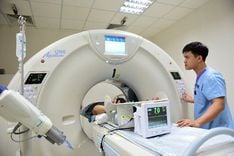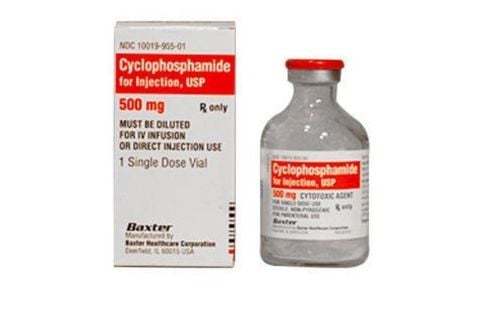This is an automatically translated article.
The article was professionally consulted by Specialist Doctor II Bui Le Phuoc Thu Thao - Radiotherapy Doctor - Oncology Center - Vinmec Central Park International General Hospital.Radiation therapy is one of the most widely used cancer treatment methods in medicine. There are many different types of radiation therapy such as accelerator radiation therapy, dose modulated radiation therapy or brachytherapy...
1. External beam radiation therapy
1.1. Radiation therapy with accelerators Radiation therapy with accelerators can be understood as a method of radiation therapy that uses accelerators, which are devices that increase the speed of movement of charged or uncharged electrons. (X-rays, photons...) thereby increasing the ability to kill cancer cells and reduce cancer treatment time compared to other conventional devices.This technique is applied to many types of cancer with many different locations. It can be as a radical treatment, or adjuvant radiation therapy after another treatment such as surgery to reduce the recurrence rate, increase the ability to control the tumor.
In some cases, radiation therapy is superior to surgery because radiation therapy is better organ preservation, can reach areas that surgery cannot reach, or can be performed in patients who are not comfortable. beneficial for surgery such as elderly patients, patients with severe medical comorbidities.
Advantages of this method over other radiation therapy methods:
Can choose the energy level, beam intensity depending on the size and depth of the tumor location. Safe because there is a mode to stop beaming when the machine is turned off. Unlike the cobalt radiotherapy machine, the radioactive material still decays continuously when the machine stops working. Therefore, with the previous Cobalt radiation machines, the risk of exposure to radioactive sources of patients and medical staff is very high, which can cause many health effects. In addition, with the Cobalt radiation machine, the radioactive activity will decrease over time, the measurement and test of the dose must be performed regularly, and it is not convenient to adjust the beam intensity and energy level accordingly. with each patient, limiting the optimization of treatment plan Save time, no pain for the patient. However, this method is quite expensive compared to other methods.

1.2. Dose-modulated radiation therapy (IMRT) IMRT is a highly accurate advanced radiotherapy technique that uses a computer-controlled linear accelerator that projects radiation beams of varying intensities from many different directions. to the tumor with radiation dose and precise location, more suitable than 2D, 3D and 3D-CRT radiotherapy techniques. The technique is widely used for the treatment of prostate cancer, brain cancer, head and neck cancer (oropharynx, oral cavity) or pelvic cancer (rectum, uterus, cervix) ) and other cancers at an early stage in a location that is not suitable for surgery.

Procedure:
Examining and explaining to the patient about the IMRT technique. Simulated CT scan in the treatment position. Build 3D images of patients on a treatment planning system based on simulated CT images. Locate and plot the tumor with important organs on the patient's 3D image. Make a treatment plan and conduct treatment. Treatment usually lasts from 25-35 days depending on the tumor and the patient's health condition. 1.3 Arc Volume Modulated Radiation Therapy (VMAT) VMAT is a variant of IMRT, known as arc volume modulated radiotherapy. This technique also uses an accelerated radiotherapy machine, however, the way the beam is delivered is optimized by the fact that the beam generator will emit the beam when the machine moves in one or more arcs around the patient's body axis, helping to shorten the time. Treatment time is only a few minutes.
Indications for this technique are similar to those of IMRT. In addition, in some cases, the tumor is treated right next to the precious organs or the tumor is large, with conventional radiation techniques that may not protect the healthy organs or ensure the sufficient dose to the tumor, this technique is advantageous. than.
Advantages:
Allows high-dose radiation treatment at the tumor precisely, increasing the ability to control the tumor and limiting side effects on healthy tissues. Allows simultaneous radiation therapy of many different doses of radiation into different treatment volumes, helping to shorten the treatment time, increase the ability to destroy the tumor and reduce the cost of treatment for the patient. In addition to the above techniques, in external radiotherapy, there are a number of other techniques that are also applied in cancer treatment such as stereotactic radiotherapy (also known as body positioning radiosurgery and nervous system radiosurgery). These techniques are being implemented at Vinmec Central Park Hospital.
Trắc nghiệm: Thử hiểu biết của bạn về bệnh ung thư
Ung thư là nguyên nhân gây tử vong hàng thứ 2 trên thế giới. Thử sức cùng bài trắc nghiệm sau đây sẽ giúp bạn có thêm kiến thức về yếu tố nguy cơ cũng như cách phòng ngừa bệnh ung thư.
Bài dịch từ: webmd.com
2. Brachytherapy
Brachytherapy is the general name of a radiotherapy technique in which a source of radiation is delivered close to the tumor. In terms of classification, this technique can be classified according to:brachytherapy according to the location of the lesion:
brachytherapy in the sinuses and cavities (eg, brachytherapy for cervical cancer, cancer) nasopharyngeal radiation Contrast radiation therapy in tissues (radiotherapy is introduced into the tumor by inserting a needle through the tumor, for example radiation therapy for cancer of the tongue, lips, prostate cancer... ) Brachytherapy in the lumen of the tube (eg brachytherapy for esophageal and bronchial cancers) Brachytherapy by source delivery method :
brachytherapy with immediate source delivery. direct source conduction brachytherapy.
3. Metabolic radiotherapy
Radiotherapy is a technique of radiation therapy that uses radioactive substances to be introduced into the body by mouth or injection. After entering the body, radioactive substances will be concentrated in the cancerous tissue. Here, the radiopharmaceuticals will emit alpha or beta radiation capable of killing and killing cancer cells. For example, treating thyroid cancer with radioactive iodine.4. Combined radiation therapy

Cancer treatment has always been a dilemma in the medical profession and a fear of everyone. in the world in general and of patients in particular. Currently, after the examination process, based on the diagnosis and subclinical tests, the doctors of Vinmec hospital have selected each type of radiation therapy suitable for each patient and each type of tumor. difference. Therapeutic efficacy and success rate of radiotherapy processes is up to 95% for each case. Please contact us for the most timely and optimal treatment advice.
Radiation therapy for cancer is a method that is widely used in medicine. Currently, Vinmec Central Park International General Hospital has successfully applied this method to treat many cancer cases, helping to reduce clinical symptoms and limit cancer metastasis.
Oncology Department at Vinmec Central Park is fully equipped with cancer treatment modalities: From surgery, radiation therapy, chemotherapy... pain treatment and palliative care. The diagnosis is made carefully: blood test, X-ray, ultrasound, magnetic resonance imaging, myelogram, myelogram, biopsy, immunohistochemistry, biological diagnosis molecule.
The treatment process is closely coordinated with many specialties: Center for Diagnostic Imaging, Laboratory Testing, Cardiology, Department of Obstetrics and Gynecology, Department of Endocrinology, Department of Rehabilitation, Department of Psychology, Department of Medicine. Nutrition, Pain Treatment and Palliative Care Department, in order to bring patients the optimal treatment regimen and the most reasonable cost.
Specialist II Bui Le Phuoc Thu Thao has nearly 15 years of experience in direct treatment of cancer patients, especially radiation oncology and care for terminal cancer patients, palliative care mild and pain-relieving. Dr. Thao has participated in many advanced training courses at home and abroad such as advanced radiation therapy in Singapore and Korea, and the National Palliative Care Instructor training course of Harvard University. Currently, Dr. Thao is working at the Center for Cancer - Radiation Therapy, Vinmec Central Park International General Hospital.
Customers can go directly to Vinmec Central Park to visit or contact hotline 0283 6221 166, 0283 6221 188 for support.
MORE:
Things to know about radiation therapy for breast cancer Information to support patients receiving radiation therapy for lung cancer Notes when taking care of radiation cancer patients














